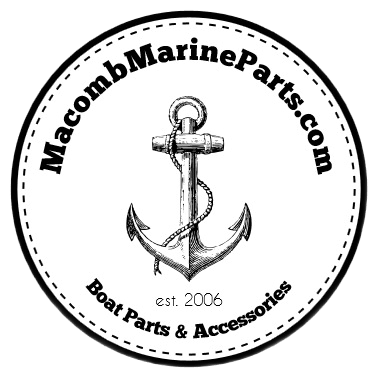Protect your order from Loss or Damage
Yamaha 200-250 HP Outboard Magnesium Anode Kit | Martyr CMY200250KITM
Yamaha 200-250 HP Outboard Magnesium Anode Kit | Martyr CMY200250KITM
Martyr (Canada Metal)
Buy Now Only: 4 Left!
Couldn't load pickup availability
Yamaha 200-250 HP Outboard Magnesium Anode Kit | Martyr CMY200250KITM
Yamaha Outboard Magnesium Anode Kit | Martyr CMY200250KITM
Martyr anode kit includes anodes needed to protect various Yamaha 200-250 HP outboard motors from corrosion in fresh water lakes and rivers.
Martyr Yamaha Outboard Magnesium Anode Kit | CMY200250KITM
- Yamaha anode kit 200HP-250HP
- Fits Yamaha F200TXR, LF200TXR, V200TLXR, F225TXR, F225TUR, LF225TXR, LF225TUR, V225TXR, S225TXRX, F250TUR, F250TXR, LF250TXR, LF250TUR and S250TXRX model outboards
- Kit includes CM6G54525101M bracket anode and CM61A4537100M skeg anode
- Magnesium anodes for use in fresh water applications
- Martyr anodes are made of a high purity specialized alloy based on the US Mil Spec
- Supplied with mounting hardware for anodes
Fit the correct anode material for the waters in which your vessel operates
As a general rule, owners should fit anodes appropriate for the environment in which they most frequently berth, and the infomation below serves as a useful guide:
- Saltwater vessels should use Traditional (Zinc) Anodes
- Brackish water Vessels should use Premium (Aluminum) Anodes
- Fresh water vessels should use Fresh (Magnesium) Anodes
Anodes (Magnesium) Fresh
Some boats will alternate between salt and fresh water. Others are docked in marinas or behind tidal barriers. The water there is contained and likely to be brackish or nearly fresh. To avoid corrosion, boat owners must be aware of the consequences this may have on their vessels. Boat owners can then install the proper cathodic protection system.
Not all anodes are appropriate for every application
For example, after a period of time in fresh water, the surface of a zinc or aluminum anode will become covered with an off-white crust of oxide, essentially sealing the anode and preventing it from functioning even when restored to saltwater. Zinc anodes have a similar difficulty even in brackish circumstances, however aluminum will continue to perform well in river estuaries and other brackish water areas indefinitely. Because the anode is passive, the next most anodic component in the anode bonding system will begin to sacrifice itself, which might be disastrous.
As a result, it is critical to inspect zinc and aluminum anodes after any trips into fresh water. If necessary, clean or replace the anodes. Martyr recommends that if a vessel is in fresh water for more than two weeks, an alternative anode system suitable for fresh water situations be used.
Magnesium anodes, on the other hand, have a much higher driving voltage than zinc or aluminum, making them ideal for use in fresh water; however, they will become very active in salt water, where they will likely last only a few months. Protected surfaces can accumulate an off-white calcareous deposit that is difficult to remove.
Magnesium anodes are not intended for prolonged use in salt water, and if you plan to leave your boat in salt water for more than seven days (fourteen days in any given year), you should consider replacing the anodes.
Yamaha 200-250 HP Outboard Magnesium Anode Kit | Martyr CMY200250KITM
Yamaha Outboard Magnesium Anode Kit | Martyr CMY200250KITM
Martyr anode kit includes anodes needed to protect various Yamaha 200-250 HP outboard motors from corrosion in fresh water lakes and rivers.
Martyr Yamaha Outboard Magnesium Anode Kit | CMY200250KITM
- Yamaha anode kit 200HP-250HP
- Fits Yamaha F200TXR, LF200TXR, V200TLXR, F225TXR, F225TUR, LF225TXR, LF225TUR, V225TXR, S225TXRX, F250TUR, F250TXR, LF250TXR, LF250TUR and S250TXRX model outboards
- Kit includes CM6G54525101M bracket anode and CM61A4537100M skeg anode
- Magnesium anodes for use in fresh water applications
- Martyr anodes are made of a high purity specialized alloy based on the US Mil Spec
- Supplied with mounting hardware for anodes
As a general rule, owners should fit anodes appropriate for the environment in which they most frequently berth, and the infomation below serves as a useful guide:
- Saltwater vessels should use Traditional (Zinc) Anodes
- Brackish water Vessels should use Premium (Aluminum) Anodes
- Fresh water vessels should use Fresh (Magnesium) Anodes
Some boats will alternate between salt and fresh water. Others are docked in marinas or behind tidal barriers. The water there is contained and likely to be brackish or nearly fresh. To avoid corrosion, boat owners must be aware of the consequences this may have on their vessels. Boat owners can then install the proper cathodic protection system.
For example, after a period of time in fresh water, the surface of a zinc or aluminum anode will become covered with an off-white crust of oxide, essentially sealing the anode and preventing it from functioning even when restored to saltwater. Zinc anodes have a similar difficulty even in brackish circumstances, however aluminum will continue to perform well in river estuaries and other brackish water areas indefinitely. Because the anode is passive, the next most anodic component in the anode bonding system will begin to sacrifice itself, which might be disastrous.
As a result, it is critical to inspect zinc and aluminum anodes after any trips into fresh water. If necessary, clean or replace the anodes. Martyr recommends that if a vessel is in fresh water for more than two weeks, an alternative anode system suitable for fresh water situations be used.
Magnesium anodes, on the other hand, have a much higher driving voltage than zinc or aluminum, making them ideal for use in fresh water; however, they will become very active in salt water, where they will likely last only a few months. Protected surfaces can accumulate an off-white calcareous deposit that is difficult to remove.
Magnesium anodes are not intended for prolonged use in salt water, and if you plan to leave your boat in salt water for more than seven days (fourteen days in any given year), you should consider replacing the anodes.








